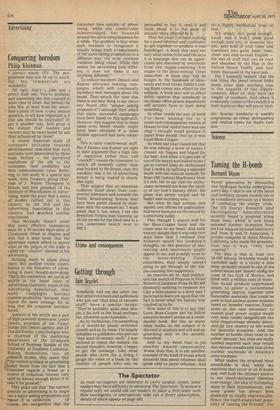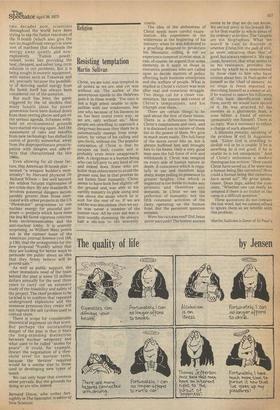Science
Taming the H-bomb
Bernard Dixon
Power generation by detonating two hydrogen bombs undergound every day that is one of the latest and certainly zaniest notions yet to be considered seriously as a means of combating the energy crisis.. The US Energy Research amd Development Administration recently heard a proposal along these lines, which is now being assessed further. Scientists from the Los Alamos national laboratory and from R and D Associates, a private company in Santa Monica, California, who made the presentation, say it was "very well received."
The idea is that at least two 10-100 kiloton H-bombs would be exploded daily in a cavity a mile deep, probably mined in one of the subterranean salt 'domes' along the coast of the Gulf of Mexico, and filled with a million tons of water. This would produce superheated steam, to power a conventional generating station, together with fissionable materials that could be used to fuel nuclear power stations based on 'breeder' reactors. Explosions at the rate necessary to sustain peak power output would very soon render insignificant the total megatonnage already detonated by any country in the world for peaceful purposes. And the number of bombs (they tend to be called 'devices', but they are really bombs) required each year would also exceed considerably that of the nuclear warheads in America's arms stockpile.
What makes the proposal most remarkable is that, while the reactions that occur in an H-bomb may well hold the ultimate answer to our much-discussed dilemma over energy, the idea of harnessing them in their instantaneous, awesome power has always been dismissed as totally impracticable. Hence the much-researched possibility of 'taming the H-bomb'. For two decades now, scientists throughout the world have been trying to tap the fusion reactions of the H-bomb (which also give the sun its magnificent energy) in some sort of machine that channels the energy away quietly and non explosively. 'Fusion power,' indeed, looks like providing the best, cheapest, and safest long-term solution to our problems. But it is being sought in esoteric equipment, with names such as Tokamak and Jet, precisely because the possibili ty of deriving useful energy from the bomb itself has always been considered out of the question.
But such has been the panic triggered by the oil sheikhs that many lunatic ideas for power generation have been dusted down from their resting places and put on the serious agenda. Schemes withheld on environmental grounds have started moving again. And the assessment of risks and benefits from new technology has shifted its Centre of gravity somewhat, away from the disproportionate preoccupation with dangers and side-effects that characterised the late 1960s.
Even allowing for all these factors, this American H-bomb plan — termed "a weapon builder's monstrosity" by Harvard physicist Dr Richard Wilson — lies well beyond the wildest futurist nightmares of pre-crisis days. By any standards, it involves potential dangers incom parably greater than those associated with other projects in the US "Plowshare" programme to use nuclear energy for peaceful purposes — projects which have none the less 1911 faced vigorous criticism from environmentalists and the anti-nuclear lobby. It is scarcely surprising, as William Metz points out in the current issue of the American journal Science (vol 188, p 136), that the protagonists for the new proposal "frankly admit that they are looking for better ways to persuade the public about an idea that they firmly believe will be proved safe."
As well as public support, the other immediate need of the team behind the plan is some 13 million dollars annually for the next three years to carry out an extensive study of the feasibility and safety of the project. The chief problem to be tackled is to confirm that repeated underground explosions and the immense pressures they create will not rupture the salt cavities used to contain them.
There is scope for considerable theoretical argument on that score.
But perhaps the outstanding danger of the plan is that it blurs the long-standing distinction between nuclear weaponry and what used to be called "atoms for peace". It could, for example, thwart the negotiation of a threshold level for nuclear tests, because the 'devices' required would be a similar size to those used in developing new types of bomb.
We can only hope that common sense prevails. But the grounds for doing so are slim indeed.











































 Previous page
Previous page